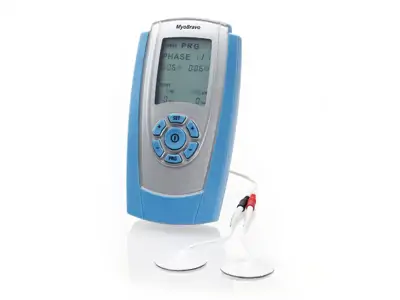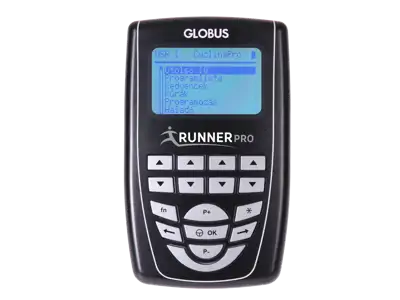Sports stimulator
A sports muscle stimulator is not a substitute for exercise, but a supplement to it. It has different "benefits" for the professional and the amateur.
Read more...Muscle stimulation is not a substitute for training, but a complement to it, with different "benefits" for the professional sportsperson and the amateur who trains while studying or working. The applications are many and varied, so it is up to you to decide for yourself what you want to "use" it for! One thing you can be sure of is that if you use it regularly, you will notice the positive effects, just as you would if you exercise regularly. Let's take a look at what athletes can use muscle stimulators for.
Muscle Stimulation Applications for Athletes
Muscle Recovery Acceleration
If you haven't used a stimulator before, try muscle recovery treatments first!
Apply electrodes to the most used muscle after a strenuous workout. A series of studies show that muscle stimulation is more effective than any other method of recovery in reducing metabolites and therefore muscle fatigue and stiffness.
Stimulation of the muscle within 90 minutes of exercise increases blood flow by up to 300%, speeding up the pumping and flushing of waste products from the muscle. Most of the metabolites are broken down in the liver, so the sooner they get there, the sooner muscle stiffness and fatigue are released. It shortens recovery time and prevents muscle cramps.
The acceleration of circulation not only helps to speed up the transport of fat, but also to replenish muscle stores.
A properly treated muscle after exercise is significantly fresher and more rested for the next workout, allowing for more efficient workload.
Muscle Injury Treatment
Muscle stimulation was originally a medical, hospital-based treatment that began to be used to repair muscle injuries. In the case of a sports injury, it is important for you to return to training as soon as possible.
Muscle stimulation does not move the joint, so you can start muscle recovery treatments the day after any tendon, ligament, joint capsule or cartilage injury!
After a muscle injury, you need to wait a few days for the bleeding to stop. But you can apply it 3-4 days after the injury. It increases blood and lymph circulation, which brings the nutrients needed for healing to the site of the injury. This speeds up the recovery of muscle fibres.
Muscle Strength Recovery
You are condemned to prolonged bed rest after a fracture, cartilage surgery, ligament surgery, etc. The longer the enforced rest, the more muscle strength and mass you lose from your strenuous training. After two to three weeks of rest, roughly half a year's worth of training will be wiped out.
Since stimulation does not move the joints, you can start muscle-preserving or muscle-strength-recovery exercises a few days after surgery. By the time your joints are allowed to move, your muscles are already prepared to do so. That means you can bring your return forward by weeks!
Rehabilitation can further speed up your recovery by combining physiotherapy movements with stimulation. Stimulation can be done at the same time as voluntary movement, which helps to "retrain" neuromuscular function.
"lagging" muscle development
Some people find that training a particular muscle in the traditional way, in vain, does not help it to develop. With electrical muscle stimulation, however, you can "target" even a single muscle, plus you can decide which muscle you want to "tweak". In isolation, you can 'fine-tune' endurance, aerobic tolerance, increase muscle strength and explosiveness or even increase muscle mass. Attention! The effect only occurs on the muscles treated!
training time "gain"
Most athletes do not have enough training time to exercise while having a family, working or studying. Those whose jobs are office-based and stationary can "gain" training time with muscle stimulation. Passive muscle stimulation while sitting also gives the muscle an extra workout! It's just like training one more!
Obviously, this way you should only treat the muscles that are most important for your sport. For a runner or cyclist, the thigh muscles, for a swimmer, the wide back muscles that provide thrust, etc.
You can target your treatment, if you're a sprinter, you'll need to increase muscle strength and explosiveness. For long-distance sports, muscle endurance and aerobic-anaerobic tolerance are crucial, so you need to adjust the impulse accordingly.
avoiding recurrence
Imagine a situation: you squat with a barbell during a strength training session and the next day your knee hurts. You think, "Yeah... it's from yesterday. Never mind, I'll push". You do the prescribed. But the next day the pain is still there, and now it even seems to sting. But again, you exercise. So it goes on for two or three weeks before you realise it's an overuse injury that needs to be "rested". The inflammation is not going to go away if you put any weight on it. Yes, it does, but if you miss 2-3 weeks, you've put in the last 3-4 months of hard work and you can't get back into it this season.
This is when the muscle stimulator comes in. As long as you're resting the joint (i.e. not doing any traditional movement that puts stress on your knee), you can maintain the condition of your leg muscles with stimulation!!!! In other words: even if you don't run or cycle for 2 weeks, your hamstrings will still stay intact! Once your knee has recovered and you're training again, you can practically pick up where you left off.
Another similar area is of interest to high level athletes. For those who train for a race twice a day, travelling to a distant race is a serious problem. During a 30+ hour flight the muscles stiffen up and at this level even a two day lay off "shows". In such cases, a muscle stimulator is an invaluable asset. It fits in your pocket, you can use it on the plane and it will keep your most important muscles fully maintained. Once you arrive at your destination, there'll be no sign of muscle fatigue.
What's in it for the pro?
The life of a professional athlete is all about training. He has nothing to do but train as intensively as possible and maximise his progress. But when the workload is heavy, your muscles become increasingly fatigued and need more rest.
While resting, your muscles replenish nutrient and energy stores, remove metabolites, repair micro-injuries. It is during rest that supercompensation, or the "incorporation" of training work, occurs. Your body optimises its circulatory-respiratory-metabolic processes for the workload. Muscle fibres are strengthened, blood supply improves, metabolism adapts to tolerate oxygen deprivation, and cardiorespiratory efficiency improves. These are slowly adaptive processes that only develop in response to sustained effective exercise.
If you don't take care of rest, you will also slow your progress, and overwork can even lead to a downward spiral and increase your risk of injury!
If you don't rest, your muscles will retain metabolites that make them tired, stiff and inflexible. If you keep trying to exercise despite this, if you keep pushing yourself to meet the prescribed dose, suddenly your knees, ankles, Achilles, shoulders or any of your muscles and joints start to ache. Chronic overuse can lead to inflammation, which can take months to resolve. Of course, many people don't stop despite the pain, because racing is more important ... and then suddenly there's a crack and there goes the Achilles tendon, cruciate ligament, rotator cuff, etc.
What happened? Nothing much ... you just trained mindlessly ... you didn't listen to your body's signals, you didn't let it recover, rest, supercompensate.
Muscle stimulation for the pro gives the most benefit by accelerating muscle recovery!
There are two pathways to recovery: pre- and post-workout stimulation.
The pre-workout is called a warm-up. Such stimulation prepares you for movement, increases blood circulation, warms up and makes tendons, ligaments and muscles flexible. The vast majority of sports injuries result from failure to warm-up properly (read my article on this). Stimulation can significantly reduce the risk of this.
Muscle stimulation treatment (recovery programs) immediately after exercise, but within 90 minutes or less, removes 35-50% of metabolites (lactic acid, CK)! This brutally speeds up the elimination of waste products, shortens the time needed for muscle recovery and reduces fatigue. Fatigue is not a problem in your next workout, you don't have to cut back on intensity. And if you can train at a higher intensity, your progress will be faster! Your risk of injury is also significantly reduced.
Injury management and muscle strength maintenance
High workloads are associated with minor to major muscle and joint injuries, which are the main area of medical application of muscle stimulation. If you are forced to miss training due to injury, your muscles can lose the results of several "months" of training in a few days. For example, if an ankle strain forces you to take 10 days off bed rest, you could lose the strength your leg muscles have built up over six months. Muscle stimulation doesn't stress (move) the joints, meaning you can treat your calf and thigh muscles within hours of an ankle injury (as soon as the bleeding stops). This way, you can maintain muscle strength and prevent "wear and tear"!!!!
Similarly, if you are travelling to a distant competition. Up to two days can go by idle while you arrive at a remote venue and you'll feel the effects of missing the race. With muscle stimulation on the plane, bus, wherever, you can train your core muscles and maintain muscle strength, keeping your muscles fresh.
Helping you where you're stuck
Despite lots of training, some of your muscles aren't developing the way you'd like. One side is weaker than the other (e.g. due to a previous injury) and this lopsidedness puts strain on your waist, etc. With a muscle stimulator you can correct these deficiencies. You can focus on a single muscle or muscle group very effectively.
There are many other possibilities with the muscle stimulator. If you're a professional athlete, you can't be without one in your gym bag today. You'll thank me!
What's in it for the amateur?
Most of the same things as the pro (read the previous chapter) and then some.
The amateur is typically "out of practice". He/she trains while studying, working, and raising a family, and therefore usually doesn't have as much time to train as he/she would like, and especially not enough to achieve the time results he/she is aiming for. He just drops in from work and starts training without a proper warm-up. That's why injuries are so common. A little progress is followed by a setback, usually not achieving what you want.
Stimulators are recommended for those who have enough time for stimulation! If you do office work, you can be a big "beneficiary" of this technology. If you are in constant motion, you won't have the time or opportunity to stimulate, so for you it will only play a role in injury management.
The cyclist concentrates stimulation on his thigh muscles, the wrestler on his core muscles, the swimmer on his broad back muscles, etc. In other words, the muscles that are essential to their sport. It is worth concentrating 80% of the stimulation time on these muscles.
Naturally, it is not a substitute for traditional training, which is still necessary to adapt the circulation and breathing and improve movement coordination. However, the treated and important muscles will reward the treatment in a spectacular way.
Is muscle stimulation useful for the athlete?
Guaranteed!
While technical innovations such as a lighter bike or running shoes are only an external aid, i.e. they don't actually improve your performance (they only contribute slightly to improving your results), muscle stimulation is a whole other dimension!
Muscle stimulation allows you to maximise the potential of your muscles - it improves your performance in both direct and indirect ways! Of course, only if you use it. It has no effect if kept on the shelf. But if you use it regularly as part of your training work, you can expect a significant increase.
Back to top...






